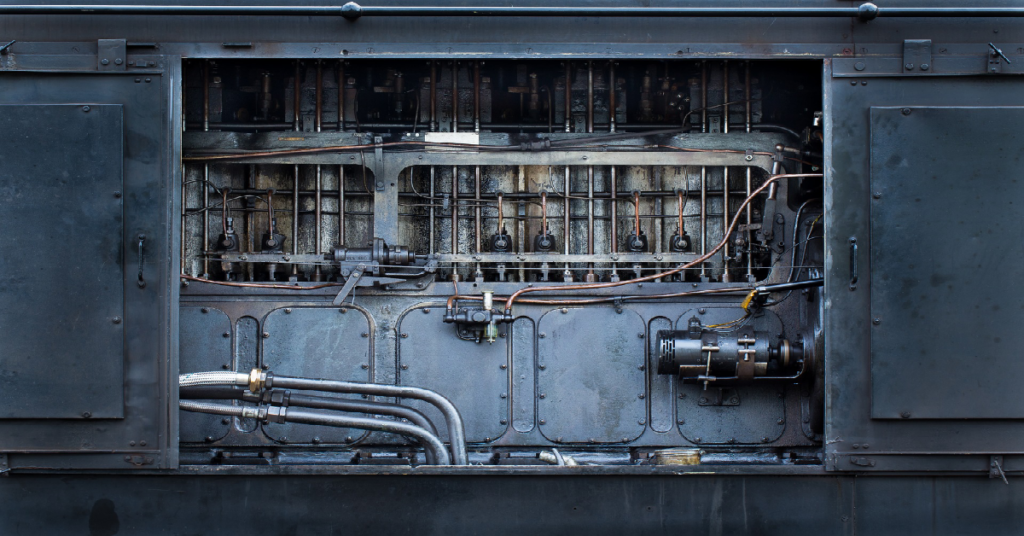In an aircraft, the engine is made up of several components that make the engine propel the aircraft.
Depending on the type of drive machine, a distinction is made between piston and turbine engines, and depending on the type of propulsion generated, between propeller and jet engines. Rocket engines are also used in the military field.
All types of aircraft engines are heat engines.
In the early days of aviation, piston engines, which moved a propeller (air screw), were widespread. In the early days, they were made of wood and, depending on the engine’s power, had a diameter of around 1.5 meters and 6.5 meters.
Water or air-cooled four-stroke petrol engines were mostly used as piston engines. Propulsion was provided by propellers generated.
The engine types are differentiated according to the arrangement of their cylinders concerning the crankshaft in inline, boxer or radial engines.
The largest piston aircraft engines were installed in passenger planes such as the Lockheed “Super Constellation” in the 1950s.
These highly complex engines delivered around 3,000 hp and were designed as supercharged radial engines with 27 cylinders in three stars in a row. However, the engines required a lot of maintenance, and the propellers limited the achievable speed.
While the first disadvantage could be overcome by the development of turboprop engines, the advent of jet engines brought a noticeable increase in speed and range from the late 1950s onwards at low cost and maintenance expense.
Piston engines are now limited to slow-flying transport aircraft, sports aircraft and ultra-light aircraft.
The advantage of the propeller turbine over the Otto engine is the small number of moving parts so that a PTL engine works more reliably and is lighter with the same performance.
Since the rotational movement is largely smoother than the up and down movement of the pistons, a PTL engine operates more quietly and without the vibrations typical of piston engines. The advantage of pure jet propulsion is the higher economy in the medium speed range from about 400 km/h to 800 km/h.
What Are The Advantages Of Piston-Engine Aircraft
Piston engines are among the most common engine types in aviation.
Although jet engines have been surpassed in popularity, piston engines are still used in many small and regional cabin aircraft.
Some of the distinctive characteristics of piston engines in aeronautics compared to other engines in aeronautics are related to various factors.
For example, aviation piston engines have a much slower rotation speed than jet engines.
They also have limited power compared to jet engines, limiting their use in large, high-speed aircraft.
However, piston engines have a big advantage in fuel efficiency and are more suitable for small and regional cabin aircraft that do not require high speeds.
Internal combustion engines, such as piston engines, use thermal energy from burning fuels like gasoline or kerosene to produce mechanical energy.
These engines are so-called because they use pistons to convert thermal energy into mechanical energy.
What Are The Advantages Of Gas Turbine Engine Over Piston Engine
Let’s list the advantages below;
1. Very high energy-to-weight ratio compared to piston engines;
2. Smaller than most piston engines of the same power rating.
3. Moves in one steering, with much less vibration than a reciprocating engine.
4. Fewer moving parts than piston engines.
5. Greater reliability, especially in applications requiring high sustained power output.
6. They allow the use of different types of fuels, such as kerosene, diesel, natural gas, and pulverized coal, provided that the combustion gases do not erode the blades or settle on them
7. Low operating pressures.
8 . High-speed operation.
9 . Low consumption and cost of lubricating oil.
10. Can operate on a wide variety of fuels.
11. Very low toxic emissions of CO and HC due to excess air, complete combustion, and failure to “temper” the flame on cold surfaces
What Is The Difference Between Piston And Jet Aircraft
A jet engine is a machine that produces thrust by transforming a fluid (air) through a series of thermodynamic processes.
These laws are based on Newton’s 2nd and 3rd Laws.
Now, let’s talk about piston engines. When fuels like gasoline or kerosene burn, internal combustion engines, such as piston engines, convert the heat energy into mechanical energy. These engines are used in aviation.
These engines are practically identical to those in automobiles, with three important differences:
• Most aero engines are air-cooled.
• Loss of coolant or failure of the cooling system of a liquid-cooled engine would result in overall engine failure. Aircraft engines have dual ignition systems, and the magnets generate the energy to create the spark.
• Magnetos do not depend on aircraft batteries since the crankshaft activates them. Additionally, each cylinder has two spark plugs or magnetos. If one spark plug or magneto fails, the other fires the spark to ignite the fuel.
Does Jet Engine Have Piston
The jet engine does not have a piston; only the reciprocating engine uses a piston.
Let me briefly guide you on how a jet engine works.
The essential operation of the jet engine consists of compression of the airflow, combustion at constant pressure and expansion, which allows the airflow to exit at a higher speed than the inlet.
It sucks in a large amount of air, accelerates it, and expels it out the back at high speed to provide thrust to the plane.
Starting with the reactor itself, the objective of all of them is to achieve a “jet” of air at high speed that comes out of the back of the engine, and due to Newton’s third law already mentioned, produces a force in the opposite direction, known as “thrust” that is capable of moving the plane.
Among the different types of jet engines, the best known are the “turbojet,” “turbofan,” and “turboprop.”

